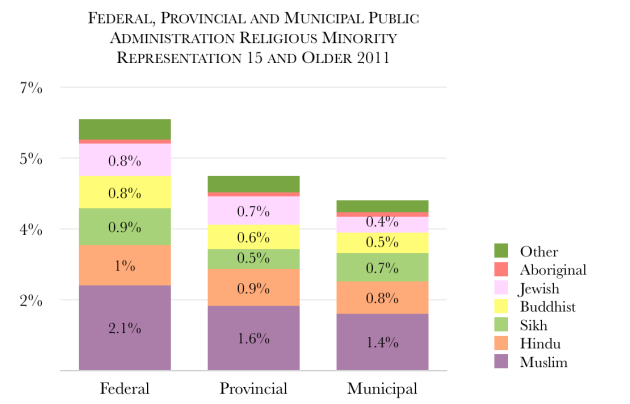Religious Minorities in the Public Service: What the data tells us
2015/10/01 Leave a comment
 To complement the employment equity analysis in my book Multiculturalism in Canada: Evidence and Anecdote (see here), I applied the same methodology using NHS data for religious minorities.
To complement the employment equity analysis in my book Multiculturalism in Canada: Evidence and Anecdote (see here), I applied the same methodology using NHS data for religious minorities.
This was prompted in part by Minister Clement’s comment that hijabs and niqabs “are frequently worn” in the public service and that “I’m sure we have employees in the public sector who wear a niqab – I’m sure we do.”
The full series of charts, tables and related analysis are found here.
The main conclusions:
Policy makers at all government levels should complement their internal employment equity data with the NHS to assess whether there are issues with respect to particular groups. This analysis of religious and visible minority data indicates that there is variation among groups, and this needs to be considered as part of employment equity strategies and programs. The five-year frequency of this NHS data also provides a longer-term view of employment equity trends than the annual government reports, which tend to focus on year-to-year changes.
Given overall demographic trends, the percentage of newer religious minorities in government will likely continue to increase. While most members of religious minorities may not need or request accommodation, the more traditional members will, and it is likely that the number and type of requests will increase.
Getting back to Minister Clement’s statement, while we know that some 8,800 Canadian Muslims work for the federal government (47 percent women), we do not have any information regarding their religiosity and the extent to which deeper religiosity is reflected in men’s facial hair or women’s head coverings (which do not mean identical religiosity, beliefs or interpretations of the respective religions). Nor do we have such information regarding other religions (e.g., Canadian Jewish public servants wearing the kippa, or Canadian Sikh public servants wearing turbans and carrying the kirpan). Nor to my knowledge is there any publicly available summary of religious accommodation requests.
We may not have hard numbers to back his assertion that “we have employees in the public sector who wear a niqab.” However, any public servant who wished to wear a niqab would provoke considerable bureaucratic discussion regarding whether this could be accommodated. That no such discussion has come to light suggests that there are no such cases at the federal level.
At some time, however, it is likely that someone will request such an accommodation (just as voting, citizenship and judicial processes have shown). While some would argue that such a request should be accommodated, this would not be healthy to an integrated workplace and society given the degree to which the face provides needed cues to interpret words.
In the interim, the public service may wish to consider collecting and analyzing data related to accommodation requests in core public administration to complement employment equity reporting and strengthen the current framework by providing a more comprehensive and consistent evidence base.
